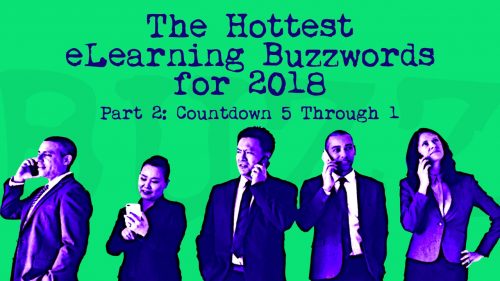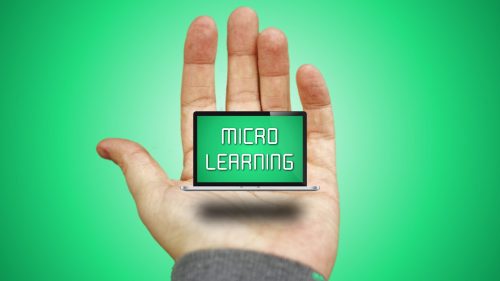
In this final installment of The Hottest eLearning Buzzwords for 2018, we complete our top ten countdown with the top five buzzwords, as revealed by a Google search. We start with the fifth most popular buzzword, Mobile Learning.
5. Mobile Learning
Mobile Learning, also know as M-Learning, is a form of remote learning where participants use mobile devices, such as mobile phones and tablets. As noted by Asha Pandey, a key advantage to the Mobile Learning approach is that it provides flexibility in delivery, allowing participants to learn at a time and place of their choosing using a variety of devices.
Additional benefits of Mobile Learning include greater engagement, since learners are more familiar with their own devices. This is particularly true of groups that have embraced mobile technologies, such as Millennials.

4. Artificial Intelligence
Artificial intelligence (AI) is the ability of a computer program to think and learn. If you’ve interacted with Microsoft’s Cortana or Apple’s Siri, then you are familiar with AI powered chatbots. These chatbots learn from how you interact with them and can personalize responses based on that interaction.
Within the realm of eLearning, AI holds promise for creating a more customized and personalized experience for learners. For example, eLearning Company has linked an AI engine to Captivate to react to natural language input, versus structured input. Additional applications involve recording user history in order to better structure courses and content.

3. Immersive Learning
Immersive Learning refers to teaching skills by placing learners in an interactive environment that emulates on-the-job or “real world” situations. A number of techniques are used that differ in the realism or “fidelity” of the simulation, such as simple low-fidelity scenarios to high fidelity simulations delivered through immersive Virtual Reality.
The key advantage of Immersive Learning, is that the closer the learning environment is to the actual situation in which a skill is used, the more likely learning transfer will occur. Additional advantages include greater learner engagement and increased safety for learning skills used in hazardous environments.

2. Gamification
Gamification is the application of gaming theory to learning experiences in simulated environments. For example, learners could be given an avatar and compete with other learners to receive points, badges or access to higher levels of the “game”.
Gamification is said to have a number of advantages, including the capability of providing rapid feedback to learners. Additional benefits include achieving more rapid learning outcomes by generating higher levels of engagement and excitement.

1. Micro Learning
Micro-Learning was the most frequently used Buzzword in the search results. Micro-Learning is a principle for structuring learning content into smaller, more manageable, lessons. These lessons are self-contained, relative short in duration (5-10 minutes) and are structured around a specific need or instructional objective.
There are a number of benefits to Micro-Learning, including more rapid development and implementation compared to longer courses. In addition, micro lessons increase both engagement and retention.
Conclusion
Love them or hate them, buzzwords are a fact of life, and the eLearning profession is rich with its own unique set of buzzwords. This list is not scientific, but was collected in a systematic manner in hopes of providing the community with insight into what eLearning professionals are talking about on the web. And so we conclude with the final list of the Hottest eLearning Buzzwords for 2018.
The Hottest eLearning Buzzwords for 2018
- Micro Learning
- Gamification
- Immersive Learning
- Artificial Intelligence
- Mobile Learning
- Social Learning
- Personalization
- Asynchronous Learning
- Analytics
- Content Curation
- Honorable Mention: Wearable Technologies
- Honorable Mention: Learning Management Systems
- Honorable Mention: Massive Online Open Course (MOOC)
- Honorable Mention: Bring Your Own Device (BYOD)References
References
Asha Pandey | What Are The Benefits Of mLearning? Featuring 5 Killer Examples
Wikipedia | Artificial Intelligence
eLearning Company | Using Artificial Intelligence in a Captivate Project
Pooja Jaisingh | Adobe Captivate (2019 release) and Immersive learning with VR experiences
Van Anh Nguyen | Top 7 eLearning Trends for 2018 You Should Know
Suresh Kumar DN | 5 Key Benefits Of Microlearning
Graphics
Rawpixel | Business People Talking on Call
Marjan Grabowski – Unsplash | Hands and Smartphone
Hitesh Choudhary – Unsplash | Man Holding up AI Post-it
Martin Sanchez – Unsplash | Man with VR Headset

In this final installment of The Hottest eLearning Buzzwords for 2018, we complete our top ten countdown with the top five buzzwords, as revealed by a Google search. We start with the fifth most popular buzzword, Mobile Learning.
5. Mobile Learning
Mobile Learning, also know as M-Learning, is a form of remote learning where participants use mobile devices, such as mobile phones and tablets. As noted by Asha Pandey, a key advantage to the Mobile Learning approach is that it provides flexibility in delivery, allowing participants to learn at a time and place of their choosing using a variety of devices.
Additional benefits of Mobile Learning include greater engagement, since learners are more familiar with their own devices. This is particularly true of groups that have embraced mobile technologies, such as Millennials.

4. Artificial Intelligence
Artificial intelligence (AI) is the ability of a computer program to think and learn. If you’ve interacted with Microsoft’s Cortana or Apple’s Siri, then you are familiar with AI powered chatbots. These chatbots learn from how you interact with them and can personalize responses based on that interaction.
Within the realm of eLearning, AI holds promise for creating a more customized and personalized experience for learners. For example, eLearning Company has linked an AI engine to Captivate to react to natural language input, versus structured input. Additional applications involve recording user history in order to better structure courses and content.

3. Immersive Learning
Immersive Learning refers to teaching skills by placing learners in an interactive environment that emulates on-the-job or “real world” situations. A number of techniques are used that differ in the realism or “fidelity” of the simulation, such as simple low-fidelity scenarios to high fidelity simulations delivered through immersive Virtual Reality.
The key advantage of Immersive Learning, is that the closer the learning environment is to the actual situation in which a skill is used, the more likely learning transfer will occur. Additional advantages include greater learner engagement and increased safety for learning skills used in hazardous environments.

2. Gamification
Gamification is the application of gaming theory to learning experiences in simulated environments. For example, learners could be given an avatar and compete with other learners to receive points, badges or access to higher levels of the “game”.
Gamification is said to have a number of advantages, including the capability of providing rapid feedback to learners. Additional benefits include achieving more rapid learning outcomes by generating higher levels of engagement and excitement.

1. Micro Learning
Micro-Learning was the most frequently used Buzzword in the search results. Micro-Learning is a principle for structuring learning content into smaller, more manageable, lessons. These lessons are self-contained, relative short in duration (5-10 minutes) and are structured around a specific need or instructional objective.
There are a number of benefits to Micro-Learning, including more rapid development and implementation compared to longer courses. In addition, micro lessons increase both engagement and retention.
Conclusion
Love them or hate them, buzzwords are a fact of life, and the eLearning profession is rich with its own unique set of buzzwords. This list is not scientific, but was collected in a systematic manner in hopes of providing the community with insight into what eLearning professionals are talking about on the web. And so we conclude with the final list of the Hottest eLearning Buzzwords for 2018.
The Hottest eLearning Buzzwords for 2018
- Micro Learning
- Gamification
- Immersive Learning
- Artificial Intelligence
- Mobile Learning
- Social Learning
- Personalization
- Asynchronous Learning
- Analytics
- Content Curation
- Honorable Mention: Wearable Technologies
- Honorable Mention: Learning Management Systems
- Honorable Mention: Massive Online Open Course (MOOC)
- Honorable Mention: Bring Your Own Device (BYOD)References
References
Asha Pandey | What Are The Benefits Of mLearning? Featuring 5 Killer Examples
Wikipedia | Artificial Intelligence
eLearning Company | Using Artificial Intelligence in a Captivate Project
Pooja Jaisingh | Adobe Captivate (2019 release) and Immersive learning with VR experiences
Van Anh Nguyen | Top 7 eLearning Trends for 2018 You Should Know
Suresh Kumar DN | 5 Key Benefits Of Microlearning
Graphics
Rawpixel | Business People Talking on Call
Marjan Grabowski – Unsplash | Hands and Smartphone
Hitesh Choudhary – Unsplash | Man Holding up AI Post-it
Martin Sanchez – Unsplash | Man with VR Headset
You must be logged in to post a comment.







